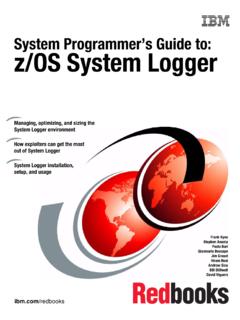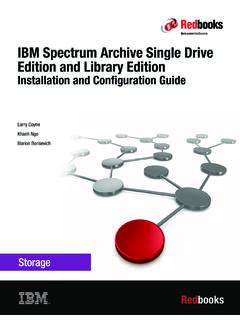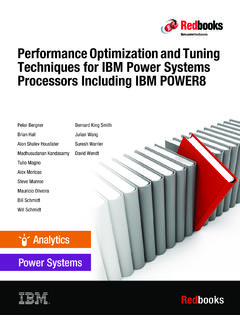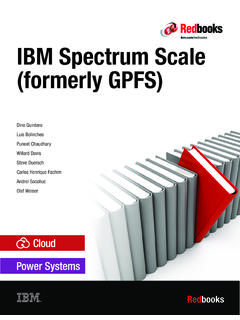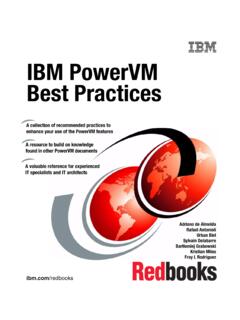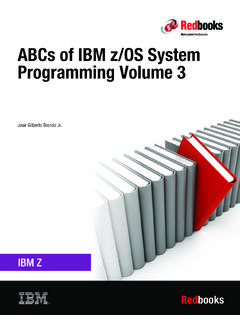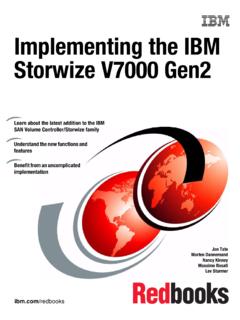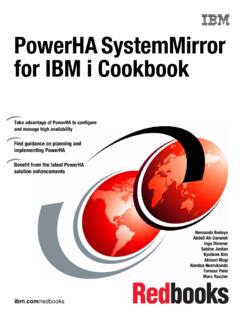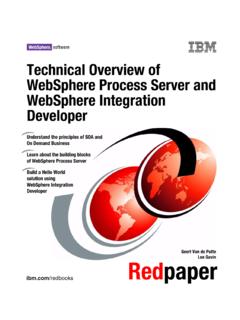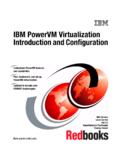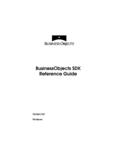Transcription of POWER7 and POWER7+ Optimization and Tuning Guide
1 Front cover POWER7 and POWER7 +. Optimization and Tuning Guide Discover simple strategies to optimize your POWER7 environment Analyze and maximize performance with solid solutions Learn about the new POWER7 + processor Brian Hall Steve Munroe Mala Anand Francis P O'Connell Bill Buros Sergio Reyes Miso Cilimdzic Raul Silvera Hong Hua Randy Swanberg Judy Liu Brian Twichell John MacMillan Brian F Veale Sudhir Maddali Julian Wang K Madhusudanan Yaakov Yaari Bruce Mealey International Technical Support Organization POWER7 and POWER7 + Optimization and Tuning Guide November 2012. SG24-8079-00. Note: Before using this information and the product it supports, read the information in Notices on page vii. First Edition (November 2012). This edition pertains to Power Systems servers based on POWER7 and POWER7 + processor-based technology. Specific software levels and firmware levels used are noted throughout the text. Copyright International Business Machines Corporation 2012.
2 All rights reserved. Note to Government Users Restricted Rights -- Use, duplication or disclosure restricted by GSA ADP Schedule Contract with IBM Corp. Contents Notices .. vii Trademarks .. viii Preface .. ix The team who wrote this book .. ix Now you can become a published author, too! .. xiii Comments welcome.. xiv Stay connected to IBM Redbooks .. xiv Chapter 1. Optimization and Tuning on IBM POWER7 and IBM POWER7 + .. 1. Introduction .. 2. Outline of this Guide .. 2. Conventions that are used in this Guide .. 4. Background .. 4. Optimizing performance on POWER7 .. 5. Lightweight Tuning and Optimization guidelines.. 6. Deployment guidelines .. 13. Deep performance Optimization guidelines .. 17. Chapter 2. The POWER7 processor.. 21. Introduction to the POWER7 processor .. 22. The POWER7 + processor .. 23. Multi-core and multi-thread scalability .. 23. Using POWER7 features .. 25. Page sizes (4 KB, 64 KB, 16 MB, and 16 GB) .. 25. Cache sharing .. 29. SMT priorities.
3 35. Storage synchronization (sync, lwsync, lwarx, stwcx, and eieio) .. 37. Vector Scalar eXtension (VSX) .. 39. Decimal floating point (DFP) .. 44. Data prefetching using d-cache instructions and the Data Streams Control Register (DSCR) .. 46. Related publications .. 51. Chapter 3. The POWER Hypervisor .. 55. Introduction to the POWER7 Hypervisor.. 56. POWER7 virtualization .. 57. Virtual processors .. 57. Page table sizes for LPARs .. 61. Placing LPAR resources to attain higher memory affinity .. 61. Active memory expansion .. 64. Optimizing Resource Placement Dynamic Platform Optimizer .. 65. Related publications .. 65. Chapter 4. AIX .. 67. AIX and system libraries .. 68. AIX operating system-specific optimizations.. 68. Using POWER7 + features under AIX .. 83. AIX Active System Optimizer and Dynamic System Optimizer .. 84. Copyright IBM Corp. 2012. All rights reserved. iii Concepts .. 84. ASO and DSO optimizations.. 86. Workloads .. 87. The asoo command.
4 89. Environment variables .. 89. Installing DSO .. 91. Log files.. 91. AIX preferred practices .. 92. AIX preferred practices that are applicable to all Power Systems generations .. 92. AIX preferred practices that are applicable to POWER7 .. 93. POWER7 mid-range and high-end High Impact or Pervasive advisory .. 93. Related publications .. 94. Chapter 5. Linux .. 97. Linux and system libraries.. 98. Introduction .. 98. Linux operating system-specific optimizations .. 98. Related publications .. 106. Chapter 6. Compilers and Optimization tools for C, C++, and Fortran.. 107. Compiler versions and Optimization levels .. 108. Advanced compiler Optimization techniques .. 109. Common prerequisites .. 109. XL compiler family.. 110. GCC compiler family .. 112. IBM Feedback Directed Program Restructuring .. 114. Introduction .. 114. FDPR supported environments.. 115. Acceptable input formats .. 116. General operation .. 116. Instrumentation and profiling.. 117. Optimization .
5 119. Related publications .. 123. Chapter 7. Java .. 125. Java levels .. 126. 32-bit versus 64-bit Java .. 126. Memory and page size considerations .. 127. Medium and large pages for Java heap and code cache .. 127. Configuring large pages for Java heap and code cache.. 128. Prefetching .. 128. Compressed references .. 128. JIT code cache .. 129. Shared classes .. 130. Java garbage collection Tuning .. 130. GC strategy: Optthruput .. 130. GC strategy: Optavgpause .. 131. GC strategy: Gencon .. 131. GC strategy: Balanced .. 131. Optimal heap size .. 132. Application scaling .. 133. Choosing the correct SMT mode .. 133. Using resource sets .. 133. Java lock reservation .. 135. iv POWER7 and POWER7 + Optimization and Tuning Guide Java GC threads .. 135. Java concurrent marking.. 136. Related publications .. 136. Chapter 8. DB2 .. 137. DB2 and the POWER7 processor .. 138. Taking advantage of the POWER7 processor .. 138. Affinitization.. 138. Page sizes .. 139.
6 Decimal arithmetics.. 139. Using SMT priorities for internal lock implementation .. 140. Capitalizing on the compilers and Optimization tools for POWER7 .. 140. Whole-program analysis and profile-based optimizations.. 140. Feedback directed program restructuring (FDPR) .. 140. Capitalizing on POWER7 virtualization .. 140. DB2 virtualization .. 141. DB2 in an AIX workload partition .. 141. Capitalizing on the AIX system libraries .. 142. Using the thread_post_many API .. 142. File systems .. 142. Capitalizing on performance tooling .. 143. High-level investigation .. 143. Low-level investigation .. 144. Conclusion .. 144. Related publications .. 144. Chapter 9. WebSphere Application Server .. 147. IBM WebSphere .. 148. Installation .. 148. Deployment .. 148. Performance .. 149. Performance analysis, problem determination, and diagnostic tests .. 150. Appendix A. Analyzing malloc usage under AIX .. 151. Introduction .. 152. How to collect malloc usage information.
7 152. Appendix B. Performance tooling and empirical performance analysis .. 155. Introduction .. 156. Performance advisors .. 156. Expert system advisors .. 156. Rational Performance Advisor .. 161. AIX .. 162. CPU profiling .. 163. AIX trace-based analysis tools .. 165. Finding emulation issues .. 170. hpmstat, hpmcount, and tprof -E.. 171. Linux.. 171. Empirical performance analysis using the IBM SDK for PowerLinux .. 172. Using the IBM SDK for PowerLinux Trace Analyzer .. 173. High library usage .. 173. Deeper empirical analysis .. 174. Java (either AIX or Linux).. 176. 32-bit or 64-bit JDK .. 176. Contents v Java heap size, and garbage collection policies and parameters.. 176. Hot method or routine analysis .. 177. Locking analysis .. 182. Thread state analysis .. 183. Appendix C. POWER7 Optimization and Tuning with third-party applications .. 185. Migrating Oracle to POWER7 .. 186. Oracle 11gR2 preferred practices for AIX and AIX on Power Systems.
8 188. Migrating Sybase ASE to POWER7 .. 193. Implementing Sybase IQ to POWER7 .. 195. Environment variables .. 195. Special considerations for Sybase IQ with SMT4 mode .. 196. Shared versus dedicated processors with Sybase IQ and POWER7 .. 196. Migrating SAS to POWER7 .. 197. Disk storage Tuning .. 200. Migrating SAP BusinessObjects Business Intelligence platform with POWER7 .. 203. Platform support .. 203. Sizing for optimum performance .. 204. Landscape design .. 204. vi POWER7 and POWER7 + Optimization and Tuning Guide Notices This information was developed for products and services offered in the IBM may not offer the products, services, or features discussed in this document in other countries. Consult your local IBM representative for information on the products and services currently available in your area. Any reference to an IBM product, program, or service is not intended to state or imply that only that IBM product, program, or service may be used.
9 Any functionally equivalent product, program, or service that does not infringe any IBM intellectual property right may be used instead. However, it is the user's responsibility to evaluate and verify the operation of any non-IBM product, program, or service. IBM may have patents or pending patent applications covering subject matter described in this document. The furnishing of this document does not grant you any license to these patents. You can send license inquiries, in writing, to: IBM Director of Licensing, IBM Corporation, North Castle Drive, Armonk, NY 10504-1785 The following paragraph does not apply to the United Kingdom or any other country where such provisions are inconsistent with local law: INTERNATIONAL BUSINESS MACHINES CORPORATION. PROVIDES THIS PUBLICATION "AS IS" WITHOUT WARRANTY OF ANY KIND, EITHER EXPRESS OR. IMPLIED, INCLUDING, BUT NOT LIMITED TO, THE IMPLIED WARRANTIES OF NON-INFRINGEMENT, MERCHANTABILITY OR FITNESS FOR A PARTICULAR PURPOSE.
10 Some states do not allow disclaimer of express or implied warranties in certain transactions, therefore, this statement may not apply to you. This information could include technical inaccuracies or typographical errors. Changes are periodically made to the information herein; these changes will be incorporated in new editions of the publication. IBM may make improvements and/or changes in the product(s) and/or the program(s) described in this publication at any time without notice. Any references in this information to non-IBM websites are provided for convenience only and do not in any manner serve as an endorsement of those websites. The materials at those websites are not part of the materials for this IBM product and use of those websites is at your own risk. IBM may use or distribute any of the information you supply in any way it believes appropriate without incurring any obligation to you. Any performance data contained herein was determined in a controlled environment.
